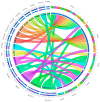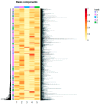Review of Patient Gene Profiles Obtained through a Non-Negative Matrix Factorization-Based Framework to Determine the Role Inflammation Plays in Neuroblastoma Pathogenesis
- PMID: 38673990
- PMCID: PMC11050151
- DOI: 10.3390/ijms25084406
Review of Patient Gene Profiles Obtained through a Non-Negative Matrix Factorization-Based Framework to Determine the Role Inflammation Plays in Neuroblastoma Pathogenesis
Abstract
Neuroblastoma is the most common extracranial solid tumor in children. It is a highly heterogeneous tumor consisting of different subcellular types and genetic abnormalities. Literature data confirm the biological and clinical complexity of this cancer, which requires a wider availability of gene targets for the implementation of personalized therapy. This paper presents a study of neuroblastoma samples from primary tumors of untreated patients. The focus of this analysis is to evaluate the impact that the inflammatory process may have on the pathogenesis of neuroblastoma. Eighty-eight gene profiles were selected and analyzed using a non-negative matrix factorization framework to extract a subset of genes relevant to the identification of an inflammatory phenotype, whose targets (PIK3CG, NFATC2, PIK3R2, VAV1, RAC2, COL6A2, COL6A3, COL12A1, COL14A1, ITGAL, ITGB7, FOS, PTGS2, PTPRC, ITPR3) allow further investigation. Based on the genetic signals automatically derived from the data used, neuroblastoma could be classified according to stage rather than as a "cold" or "poorly immunogenic" tumor.
Keywords: biomarkers; gene profiling; inflammatory phenotype; neuroblastoma.
Conflict of interest statement
The authors declare no conflicts of interest.
Figures







Similar articles
-
Gene expression profiling and identification of novel prognostic marker genes in neuroblastoma.Genes Chromosomes Cancer. 2004 Jun;40(2):120-32. doi: 10.1002/gcc.20021. Genes Chromosomes Cancer. 2004. PMID: 15101045
-
Gene-expression-based analysis of local and metastatic neuroblastoma variants reveals a set of genes associated with tumor progression in neuroblastoma patients.Int J Cancer. 2010 Apr 1;126(7):1570-81. doi: 10.1002/ijc.24889. Int J Cancer. 2010. PMID: 19739072
-
Altered expression of miRNAs and methylation of their promoters are correlated in neuroblastoma.Oncotarget. 2016 Dec 13;7(50):83330-83341. doi: 10.18632/oncotarget.13090. Oncotarget. 2016. PMID: 27829219 Free PMC article.
-
Cross-study analysis of gene expression data for intermediate neuroblastoma identifies two biological subtypes.BMC Cancer. 2007 May 25;7:89. doi: 10.1186/1471-2407-7-89. BMC Cancer. 2007. PMID: 17531100 Free PMC article. Review.
-
Neuroblastoma.Crit Rev Oncog. 2015;20(3-4):245-70. doi: 10.1615/critrevoncog.2015014033. Crit Rev Oncog. 2015. PMID: 26349419 Review.
Cited by
-
Comparative transcriptomic analysis revealed potential mechanisms regulating the hypertrophy of goose pectoral muscles.Poult Sci. 2024 Dec;103(12):104498. doi: 10.1016/j.psj.2024.104498. Epub 2024 Nov 2. Poult Sci. 2024. PMID: 39504833 Free PMC article.
References
-
- Pathania A.S., Prathipati P., Murakonda S.P., Murakonda A.B., Srivastava A., Avadhesh, Byrareddy S.N., Coulter D.W., Gupta S.C., Challagundla K.B. Immune checkpoint molecules in neuroblastoma: A clinical perspective. Pt 2Semin. Cancer Biol. 2022;86:247–258. doi: 10.1016/j.semcancer.2022.06.013. - DOI - PubMed
MeSH terms
LinkOut - more resources
Full Text Sources
Medical
Research Materials
Miscellaneous

